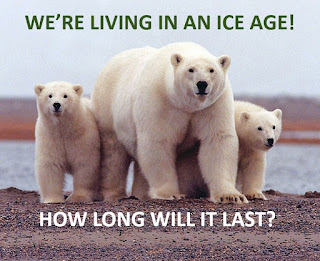 |
| All we know is ice age |
So, why do I support climate change activism? It's not a political perspective. I don't belong to a party. To a degree (pun intended), it's due to scientific studies. I do believe science is the best tool for interpreting the language of mother nature, but it's not science that convinced me to join. I joined the strike, because of a preponderance of evidence, personal experiences, and one other reason I'll share later.
The problem with the scientific method is that it doesn't often yield a conclusion as quickly as we would like or need. Such is the case with climate change. There's so much that's inconclusive, but the change is happening at an alarming rate. It's the rate that should have all of us concerned.
Within each ice age there are events referred to as "glacial" and "inter-glacial"
periods. We're in the latter, a warmer period, which began about 11,000 years ago. The ice age we're living in was at its peak around 20,000 years ago when the earth was estimated to be about 10 degrees Fahrenheit cooler. For perspective, the industrial revolution began only about 260 years ago. So, we should begin our evaluation of human impact starting around 1759 and forward. Okay, man has been burning forests for much longer, but we've seen those same forests swallow most signs of our activity by regrowth. Still, our industrial activity represents no more than a few seconds in earth's geologic time.
There are numerous potential contributors to earth's climate variations including changes in ocean and atmospheric circulation patterns, changes in atmospheric carbon dioxide, and certainly volcanic eruptions. We can easily assume that the ever changing positions of earth's continents, caused by tectonic plate movements, significantly altered ocean and atmospheric circulation patterns.
Climatologists commonly believe that today's ice age began when the land bridge between
North and South America (Isthmus of Panama) formed and ended the circulation of tropical waters between the Pacific and Atlantic Oceans.
What's does all of this have to do with global warming today? Little at most. You see, these are events that aren't happening today or they're events that take millions and, more likely, tens of millions of years to unfold. Our impact has been so great in such a brief amount of time that there is now heated debate among noted scholars as to whether we've created a new epoch. Did we create the Anthropocene in a geologic blink of an eye?
Allow me to back up. An epoch is a definable unit that geologists and paleontologists use to break down the broad concept of "deep" time. These units of time are defined by stratigraphic layers that are chemically or biologically distinct. Now, imagine that you're a geologist 10 million years from now. You're digging on an desert island in an area that was once one of LA's 4 major watersheds. How difficult do you think it would be for a scientist of the future to identify stratigraphic layers that are chemically or biologically different, and significantly different, from surrounding layers before and after our time? One thing is for certain, he or she should be wearing gloves.
I'm neither a geologist or a paleontologist, but I do know that we've moved mountains, piled trash hundreds of feet high over many thousand of square mile, flushed billions of metric tons of soil into the oceans, drilled millions of holes thousands of feet into the earth surface,
burned millions of acres of forests to the ground, spread plastic debris to the deepest depths of the ocean and the highest peaks on earth, drove hundreds of species to extinction and many more to the brink, and we've even introduced nuclear waste into earth's global oceanic and stratospheric currents on too many occasions. There's literally no place on earth untouched by our waste. Get this, it's estimated that there are 230 billion square meters of paved road on earth. In the US alone, we've covered more than 100,000 square miles with asphalt. Have you noticed how hot that stuff get's in summer? I'm not concluding anything here, it's part of the preponderance of evidence for cause.
I know, I won't change the minds of those who won't believe that man has played a role in the changing climate. Some folks just won't trust the scientific community. Perhaps, it's because they recall incidents when politicians have coerced a scientist group to modify the results of one study or another. I agree, there are reasons to be skeptical at times. For those, I can only suggest to put emotions aside and do more homework, just not on Twitter.
What are your observations? Have you ever noticed how difficult is is to walk barefoot on concrete or blacktop on a hot summer afternoon? Did you look for some grass or dirt to relieve yourself of pain from the scorching heat? Have you ever felt the hot air coming off the heat exchanger from your air conditioning unit? Why's it so much hotter than the air in the area you're trying to cool? Who's searched for a parking spot under a shade tree and wondered how many shade tree's were removed to create the parking lot? Have you ever wondered what life forms used to live where there's only blacktop and concrete today?
What I find most alarming is the way in which many folks arrive at a position or conclusion on the topic. In fact, both sides are guilty of dismissing any form of logic or reasoning at times. Case in point, I posted to several Facebook groups the day before the strike event asking who was going. Here are a few naysayer responses (I didn't correct spelling or punctuation):
- Yay New GREEN DEAL, no cow, planes,... cost trillions!
- I wonder when the last time any of them planted a tree?
- Sadly, they are indoctrinated.
- Who organized this crap? George soros?
- idiots
- First it was "global Cooling" but then it started getting warmer. Then, it was "global warming," but then it started getting cooler. Now, it's "climate change," so we're covered either way.
- Just wondering how we ever made it through the last 5 or 6 ice ages and climate change without you all
I'm convinced there's no single cause for global warming, although it seems clear that burning fossil fuels has been a major contributor. Plus, we just can't seem to keep from spilling the stuff everywhere. Still changing energy sources, however clean they may seem, won't stop the rise. We need to rely on less energy, focus on limiting manufacturing and growth for the sake of profit. We need to stop buying things to replace things that don't need to be replaced. We don't need a new phone just because Apple came out with a new one.
It's not that we all want to be hunter-gatherers or live a permaculture existence; well some us want to give it a try. Most of us understand that Mother Nature isn't dying. We're eternally incapable of killing her. She's physics, chemistry, biology, the moon and the stars. She doesn't care about us, only the processes. Of course, we're able to influence these processes. That's the issue at hand and, unfortunately, we haven't learned how to improve them.
There's so much that we/I don't understand, but it's clear that one day, for any number of reasons, the processes on earth will no longer support human life.
Now I have to ask if we can agree on one more thing. Can we agree that we all want to extend the processes that support our existence and that of future generations? This is the basis for my support. Well, that and I like the people.
As Gaylord Nelson once stated -




















